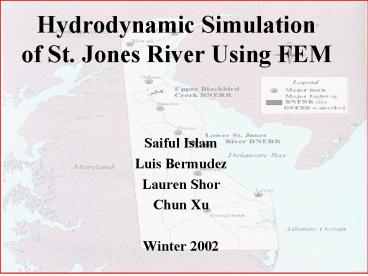Hydrodynamic Simulation of St. Jones River Using FEM - PowerPoint PPT Presentation
1 / 19
Title:
Hydrodynamic Simulation of St. Jones River Using FEM
Description:
... Open- Channel Flow', Journal of Hydraulic Engineering, ASCE, Vol. 110, no.4, ... in Open Channels', Journal of Hydraulic Engineering, ASCE, Vol. 110, no.6, June ... – PowerPoint PPT presentation
Number of Views:94
Avg rating:3.0/5.0
Title: Hydrodynamic Simulation of St. Jones River Using FEM
1
Hydrodynamic Simulation of St. Jones River Using
FEM
- Saiful Islam
- Luis Bermudez
- Lauren Shor
- Chun Xu
- Winter 2002
2
Location of St. Jones River
East Coast USA
3
Why ?
- Development of civilizations
- Nile - Egypt
- Amazon South America
- Yellow - China
Uses Agriculture Transportation Recreation Drinkin
g source
Necessity of being studied
Hydrodynamic simulation
4
Hydrodynamic Simulation
- Understand and apply the theory of FEM for
shallow waters - Generate a very non uniform triangular grid of a
water shed. - Simulate hydrodynamic behavior (Tide Wave and
profile velocities)
5
Theory of FEM For Shallow Waters
Governing Equations for 2D shallow water
In conservative form
6
Matrix Form of Governing Equations for 2D shallow
water
Non linear Hyperbolic Partial differential
p,q volumetric flow rate per unit width h
depth of the flow t time g ratio of weight to
mass Zo bed elevation from arbitrary datum n
Manning coefficient of roughness u,v velocity
components in x and y directions c (gh)1/2
celerity of elementary gravity waves
7
FEM using Petrov-Galerkin formulation
How to solve the differential equation?
- Direct method
- Variational method
- Weighted residual method
- Collocation
- Subdomain
- Least Square method
- Galerkin
Approach using FEM
Converted into an integral equation
Galerkin use on differential equations of the
form Where L is the differential operator, u is
the dependent variable
Forcing error of approximation to 0
Set of r linearly Weighting function
Orthogonal Linear combination reach the
domain Interpolation function
Variation of this function Petrov Galerkin
Formulation
8
Galerkin
Petrov-Galerkin
Better results to Galerkin method Dissipative
(oscillations of the solutions will decay with
time) Non dispersive (No wave components with
different frequencies traveling at different
speeds
9
Generation Of The Grid
Digitizing
10
Generate a Very Non-uniform Triangular Grid of a
Water Shed.
11
Cross-Sectional Data
Lower station
Middle station
Upper Station
12
75
50
25
X Y Z -75.67 39.34 0 -75.77
39.34 -6 -75.88 39.34 -2
Z
Elevation
X-section
X, distance
13
Grid
Number of triangular elements 23 122 Number of
nodes 14 556
14
Results
Elevation (m)
Flow profile of a wave as it goes upstream
15
Results
Upstream Velocity Vectors
16
Problems
- Digitizing an calibration of a big area
- Refinement of the mesh
- Sharp edges of the grid
17
Conclusions
- Numerical Methods, such as finite element methods
help scientists and engineers to understand
phenomena like flows in open channel. Governments
and institutions can manage in a more efficient
way a source like, water from rivers, so that the
community will have the water they need for
drinking, agriculture, cleaning and
transportation among others. - The grid created can be refined further and can
be used for future studies of the St. Jones River
by the Delaware National Estuarine.
18
References
- Bathe, K, Finite Element Procedures, Prentice
Hall, New Jersey, USA, 1996, Chapter 4 - Chaudhry, M.H., Open Channel Flow, Prentice Hall,
1993, Chapter 16 - Katopodes, N. , A Dissipative Galerkin Scheme
for Open- Channel Flow, Journal of Hydraulic
Engineering, ASCE, Vol. 110, no.4, April 1984,
pp. 450-466 - Katopodes, N. , Two Dimensional Surges and
Shocks in Open Channels, Journal of Hydraulic
Engineering, ASCE, Vol. 110, no.6, June 1984, pp.
794-812
19
Questions?































